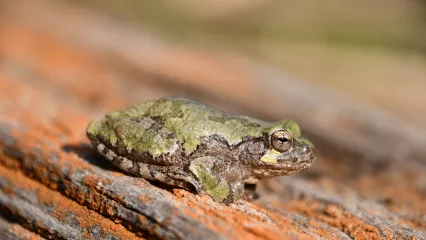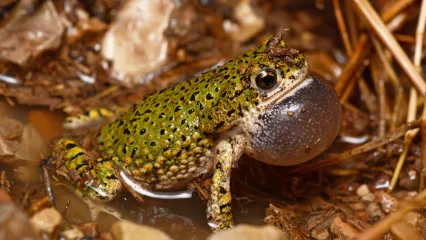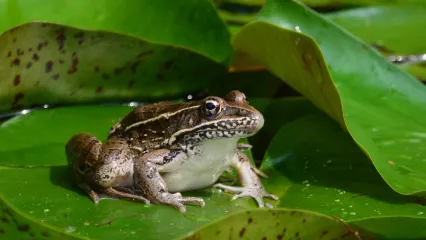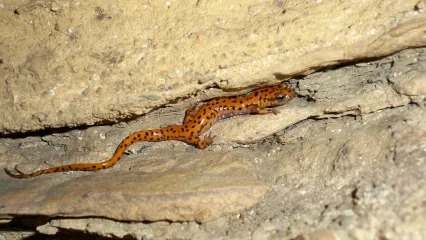
Description
Gray treefrogs (Hyla versicolor) and Cope’s gray treefrogs (Hyla chrysoscelis) are two of the most common treefrogs in the eastern half of the United States. The two species are considered together because they are “cryptic” species. In other words, the two species cannot be readily distinguished by any obvious body characteristics. Two ways they can be distinguished are by differences in their calls and differences in their chromosome number. The gray treefrog is a tetraploid species, with twice the number of chromosomes as the diploid Cope’s gray treefrog.
Gray treefrogs and Cope’s gray treefrogs are frequently pale gray with a lichen-like pattern. However, depending on temperature and other factors, they can be pale gray with no pattern to nearly white, or leaf green with no pattern. The dorsal skin is heavily granulated. A distinctive white spot, usually outlined by a dark gray line, occurs beneath the eye. The limbs are banded with the same gray/dark gray as the back. The toepads are moderately expanded. The groin and undersurfaces of the legs are deep yellow, and the chin and belly are white. They eye is light yellow with dense dark brown reticulations.
Tadpoles of these two treefrogs are very similar and cannot be distinguished from each other, but they are readily distinguished from other tadpoles. The reach nearly 2 inches in total length before transforming into froglets. The body is light brownish-yellow with iridescent gold pigmentation. The high tail fins are clear by heavily mottled with dark black blotches. In some ponds, particularly those with clear water, the clear parts of the fins are bright red. Both species of these treefrogs produce a trilling call. The difference between the calls is that the gray treefrog produces a slow trill, whereas Cope’s gray treefrog produces a fast trill. Viewed on a sonogram, the pulse rate of the two species is non-overlapping. The calls of gray treefrogs have 22.0 pulses per second, whereas those of Cope’s gray treefrogs have 35.7 pulses per second. This difference can be discerned by ear by researchers who are familiar with both species. The call of the gray treefrog sounds like a melodic trill, whereas that of Cope’s gray treefrog is a harsher trill. The eyes are gold.
Size
Adults range in size from 1.5 to 2.5 inches in length. Females are slightly larger than males. Newly metamorphosed juveniles are about 0.5 inches in length.
Habitat
The distribution of these two treefrogs has not been well established in Oklahoma. They occur together in numerous areas, even breeding in the same ponds on the same nights. Other Oklahoma populations consist only of gray treefrogs or only of Cope’s gray treefrogs. Taken together, they occur in most counties in the eastern half of Oklahoma and in some of the adjacent southwestern counties. These frogs occur throughout most of the eastern half of the U.S., with the exception of southern Florida. Apparently the range of gray treefrogs, but not that of Cope’s gray treefrogs, extends into southeastern Canada.
Life Cycle
Gray treefrogs and Cope’s gray treefrogs are late spring to summer breeders. They generally begin breeding during the first warm rains of the spring and continue through early to middle summer. In wet years the breeding season may extend into July or even into early August, but in dry years, breeding may not extend past May. The largest breeding choruses are heard in late April and May. Breeding congregations occur in farm ponds with suitable vegetation, roadside ditches, temporary ponds, and forested swamps or other wetlands. Female frogs produce about 1,800 eggs that are deposited in clusters of 30-40 eggs. The small clusters are attached to aquatic vegetation near the surface of the water. Tadpoles require 6-8 weeks to metamorphose into froglets. Froglets have been documented to disperse a half-mile from their natal waterbodies.
Like most other frogs, treefrogs feed on insects and spiders.
How To Observe
These treefrogs are not difficult to observe. They are common in eastern Oklahoma and are frequently seen on windows of houses or around porch lights at night, where they seek small insects for food. Their calls are conspicuous from April through June, depending on rainfall, and they may be found in ponds or roadside ditches by proceeding toward calling individuals with a flashlight. Tadpoles transform from June through August, again depending on the length of the breeding season, which is dependent on rainfall. Very small juveniles, about 0.5 inches in length, can be found during day or night in vegetation in wet areas around ponds or ditches, or in shrubbery, gardens, flowerbeds, or other features that are regularly watered.
(This profile was created by Dr. Laurie Vitt as part of a partnership between the Wildlife Department and the Sam Noble Oklahoma Museum of Natural History. It was funded as part of a larger State Wildlife Grant to survey and inventory amphibians and reptiles of the Wildlife Management Areas of Oklahoma: T-35-P-1.)


